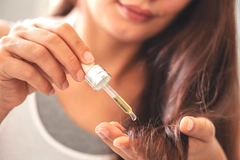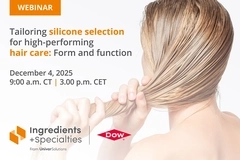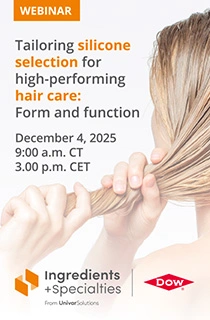Ingredients + Specialties from Univar Solutions hair care webinar preview: Getting the best out of silicones
Key takeaways
- Silicones remain essential in modern hair care, offering conditioning, shine, heat protection, and enhanced sensory performance when chosen and deposited correctly.
- Experts from Univar Solutions and Dow stress that tailoring silicone molecular weight, functionalization, and deposition strategies is key to delivering customized results across diverse hair types and product formats.
- As consumers demand science-backed efficacy and superior sensory experiences, brands are turning to advanced silicone blends and optimized delivery formats to differentiate products and drive repeat purchases.
Silicones are versatile and dependable staples in hair care. In today’s fast-paced beauty industry, using the right silicones is key to creating products that deliver results and stand out. Beyond their well-known conditioning benefits, they play a vital role in enhancing sensory properties, promoting overall hair health, and enhancing the consumer experience, enabling brands to differentiate themselves in this space.
Ahead of its webinar titled “Tailoring silicone selection for high-performing hair care: Form and function,” scheduled to be broadcast on December 4, 2025, Personal Care Insights speaks with experts on the topic of hair care and the role that silicones play.
Alienor Bianchini, EMEA technical manager, Beauty & Personal Care, Ingredients + Specialties from Univar Solutions, and Paige Engerer, technical service and application development scientist at Dow, tell us more.
How do subtle shifts in silicone molecular weight and functionalization completely change conditioning, shine, and heat-protection outcomes in modern hair care?
Engerer: Conditioning, shine, and heat protection depend on more than silicone molecular weight — it’s about the entire system. The delivery format (shampoo, conditioner, serum, or spray) and hair type (damaged, textured, or ethnic) play significant roles. Generally, higher molecular weight improves lubricity and wet combing, but deposition aids and functionalized silicones can dramatically enhance performance. Modern hair care utilizes a range of silicone technologies to tailor results to diverse consumer needs.
What do formulators often overlook about silicone deposition — and how can mastering this single principle unlock superior performance across different hair types?
Engerer: Dow has made various raw material formats and highly engineered solutions available to help ease the effort required by formulators. We offer both fluids and emulsions. We have different functionalities that will impact deposition, as well as varying particle sizes and differing ionic natures, which will also impact deposition. Formulators can certainly utilize what is available, but by mastering the concepts of deposition, we can unlock even more customization and tap into additional benefits from rinse-off formats.
We can utilize deposition aids to enhance the deposition of non-functional materials or non-ionic materials, which may offer different benefits and sensory experiences compared to functional or ionic systems. Specific deposition aids can even selectively deposit more on hair tips than hair roots. We can also opt for a substantial or light deposition, which allows us to consider the population we are targeting and their specific needs. Ultimately, understanding deposition strengthens our framework for designing solutions that cater to the variations in hair types.
In a beauty landscape demanding clean aesthetics and sensory appeal, which silicone delivery formats give brands the strongest competitive edge?
Engerer: Clean beauty means different things to different brands, but everyone wants products that feel good and perform. Silicones deliver unmatched versatility. From fluids and emulsions to functionalized options, brands can tailor performance for any format, aqueous or anhydrous. Enhanced deposition reduces usage levels, allowing multi-functional claims (such as 10-in-1) to become possible, and even rinse-off products can offer heat protection, thereby minimizing the need for additional steps. The real edge? Silicone solutions are highly tunable for both aesthetics and sensory appeal.
What insights are emerging around matching silicone choice to product format — from lightweight leave-ins to richer masks — and what does that mean for future innovation?
Bianchini: As we head into 2026, the beauty landscape is evolving. Efficacy, science, and texture are back in demand. Consumers are increasingly skeptical of soft claims. They want products that are science-backed, proven to perform, and still deliver an incredible sensory experience. This is the key to shelf adoption. A strong pitch may drive a first purchase, but repeat purchases come from products that deliver results and feel exceptional.
Looking ahead, brands are moving toward advanced silicone blends that combine volatility, viscosity, and functional groups to create tailored sensory profiles, meeting both performance and experience expectations.
As consumers demand both indulgence and functionality, how can brands use silicone science to create hair care products that genuinely stand out on the shelf?
Bianchini: Silicones have always been, and will continue to be, a standard for performance in beauty care. They help deliver efficacy, support proven results, and create exceptional sensory experiences. As the conversation shifts back to science, clinical proof, and performance, silicones stand out as a key ingredient.
Brands that are looking to win in this market can focus on:
● Creating unique sensory experience: Using silicone ingredients to deliver unique tactile profiles, silky sprays, luxurious masks, or frizz-proof creams.
● Telling your story: Highlighting benefits such as heat protection, color retention, and anti-frizz alongside sustainability credentials to appeal to eco-conscious consumers.
● Making it personal: Develop targeted solutions for different hair types, including light silicones for fine hair, richer blends for curly or damaged hair, etc.
You can register for the webinar here.














